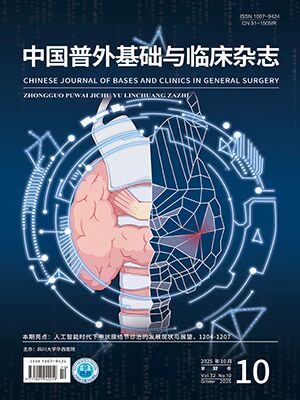| 1. |
Proctor MJ, Morrison DS, Talwar D, et al. An inflammation-based prognostic score (mGPS) predicts cancer survival independent of tumour site: a Glasgow inflammation outcome study. Br J Cancer, 2011, 104(4): 726-734.
|
| 2. |
Elinav E, Nowarski R, Thaiss CA, et al. Inflammation-induced cancer: crosstalk between tumours, immune cells and microorganisms. Nat Rev Cancer, 2013, 13(11): 759-771.
|
| 3. |
汪晓东, 刘丹, 吕东昊, 等. 结直肠癌血清纤维蛋白原和炎性介质、肿瘤标志物的术前诊断价值. 肿瘤防治研究, 2010, 37(5): 566-569.
|
| 4. |
汪晓东, 高命, 吕东昊, 等. 炎性介质 CRP 和 SAA 与肿瘤标记物 CEA、CA19-9 和 CA72-4 术前联合评估结直肠癌. 临床肿瘤学杂志, 2009, 14(4): 336-340.
|
| 5. |
Wang DS, Luo HY, Qiu MZ, et al. Comparison of the prognostic values of various inflammation based factors in patients with pancreatic cancer. Med Oncol, 2012, 29(5): 3092-3100.
|
| 6. |
Kos FT, Hocazade C, Kos M, et al. Assessment of prognostic value of neutrophil to lymphocyte ratio and prognostic nutritional index as a sytemic inflammatory marker in non-small cell lung cancer. Asian Pac J Cancer Prev, 2015, 16(9): 3997-4002.
|
| 7. |
Templeton AJ, Ace O, McNamara MG, et al. Prognostic role of platelet to lymphocyte ratio in solid tumors: a systematic review and meta-analysis. Cancer Epidemiol Biomarkers Prev, 2014, 23(7): 1204-1212.
|
| 8. |
Turner N, Tran B, Tran PV, et al. Primary tumor resection in patients with metastatic colorectal cancer is associated with reversal of systemic inflammation and improved survival. Clin Colorectal Cancer, 2015, 14(3): 185-191.
|
| 9. |
Turner N, Wong HL, Templeton A, et al. Analysis of local chronic inflammatory cell infiltrate combined with systemic inflammation improves prognostication in stage Ⅱ colon cancer independent of standard clinicopathologic criteria. Int J Cancer, 2016, 138(3): 671-678.
|
| 10. |
He W, Yin C, Guo G, et al. Initial neutrophil lymphocyte ratio is superior to platelet lymphocyte ratio as an adverse prognostic and predictive factor in metastatic colorectal cancer. Med Oncol, 2013, 30(1): 439.
|
| 11. |
Hanahan D, Weinberg RA. Hallmarks of cancer: the next generation. Cell, 2011, 144(5): 646-674.
|
| 12. |
Mariani F, Sena P, Roncucci L. Inflammatory pathways in the early steps of colorectal cancer development. World J Gastroenterol, 2014, 20(29): 9716-9731.
|
| 13. |
Goubran HA, Burnouf T, Radosevic M, et al. The platelet-cancer loop. Eur J Intern Med, 2013, 24(5): 393-400.
|
| 14. |
Coffelt SB, Kersten K, Doornebal CW, et al. IL-17-producing γδ T cells and neutrophils conspire to promote breast cancer metastasis. Nature, 2015, 522(7556): 345-348.
|
| 15. |
潘颖, 管世鹤, 杨凯, 等. 外周血血小板/淋巴细胞比值在非小细胞肺癌诊断中的价值. 细胞与分子免疫学杂志, 2016, 32(12): 1683-1686.
|
| 16. |
Jiang K, Lei J, Chen W, et al. Association of the preoperative neutrophil-to-lymphocyte and platelet-to-lymphocyte ratios with lymph node metastasis and recurrence in patients with medullary thyroid carcinoma. Medicine (Baltimore), 2016, 95(40): e5079.
|
| 17. |
Wang D, Yang JX, Cao DY, et al. Preoperative neutrophil lympho⁃cyte and platelet-lymphocyte ratios as independent predictors of cervical stromal involvement in surgically treated endometrioid ade⁃nocarcinoma. Onco Targets Ther, 2013, 6: 211-216.
|
| 18. |
Frattini M, Balestra D, Suardi S, et al. Different genetic features associated with colon and rectal carcinogenesis. Clin Cancer Res, 2004, 10(12): 4015-4021.
|
| 19. |
Templeton AJ, McNamara MG, Šeruga B, et al. Prognostic role of neutrophil-to-lymphocyte ratio in solid tumors: a systematic review and meta-analysis. J Natl Cancer Inst,2014, 106(6): dju124.
|
| 20. |
Yao M, Liu Y, Jin H, et al. Prognostic value of preoperative inflammatory markers in Chinese patients with breast cancer. Onco Targets Ther, 2014, 7: 1743-1752.
|
| 21. |
Azab B, Bhatt VR, Phookan J, et al. Usefulness of the neutrophil-to-lymphocyte ratio in predicting short- and long-term mortality in breast cancer patients. Ann Surg Oncol, 2012, 19(1): 217-224.
|
| 22. |
Wang K, Xu J, Zhang T, et al. Tumor-infiltrating lymphocytes in breast cancer predict the response to chemotherapy and survival outcome: A meta-analysis. Oncotarget, 2016, 7(28): 44288-44298.
|
| 23. |
Ertas IE, Gungorduk K, Akman L, et al. Can preoperative neutrophil:lymphocyte and platelet:lymphocyte ratios be used as predictive markers for lymph node metastasis in squamous cell carcinoma of the vulva? Eur J Obstet Gynecol Reprod Biol, 2013, 171(1): 138-142.
|
| 24. |
胡赟宏, 王铮元, 崔嵘嵘, 等. 中性粒细胞/淋巴细胞比值与血小板/淋巴细胞比值对乳腺癌复发转移的预测价值及乳腺癌预后影响因素研究. 中国全科医学杂志, 2016, 19(30): 3657-3661.
|




